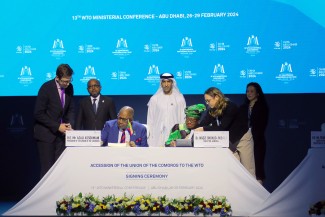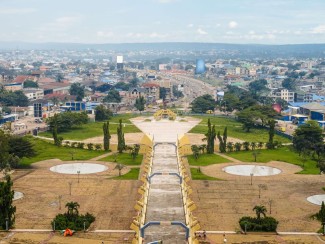Madagascar Impact Story. Explore more impact stories here.
KEY RESULTS
- While the Enhanced Integrated Framework (EIF) only has institutional capacity‑building projects with Madagascar so far, the EIF National Implementation Unit (NIU) has developed a mid-term plan based on the Diagnostic Trade Integration Study (DTIS) funded by the EIF. The mid-term plan, based on the EIF’s guidelines, has helped the Government mobilize more resources to support its trade priorities.
- The EIF supported Madagascar in integrating trade into its National Development Plan, an essential step to harness the potential of international trade for poverty reduction and achieving sustainable development. The United Nations Development Programme (UNDP) is also helping the Government of Madagascar in updating its DTIS. The Action Matrix of the updated DTIS will help to mobilize more resources from development partners to address the country's trade priorities.
Vanilla, cloves and pepper are closely associated with the island of Madagascar. These internationally high-value and in-demand products, together with textiles, coffee, cocoa, and a rich biodiversity attractive to tourists, hold great promise for the Malagasy people’s potential for economic growth, poverty reduction and sustainable development through inclusive trade. What is holding back this large island of 28 million people off the coast of southern Africa? According to the World Bank, instability has undermined investor confidence, limited access to finance and curtailed tourism, which is one of the country’s main industries.
Despite a three-decade history of political upheaval, the EIF and its precursor up to 2009, the Integrated Framework, have persisted since 2001 in supporting Madagascar’s efforts to use trade as an engine for development. In line with its ethos of building economic resilience among the world’s most vulnerable populations, the EIF continued engagement in the wake of political crises in 2002 and 2009. Madagascar has benefited from support amounting to nearly USD 2.5 million since 2002.
What has been achieved through the partnership is trust across successive governments; a country-owned framework and human resource capacity to make trade work for development; support for mobilizing additional funding from bilateral donors, multilateral development banks and private sector investors; as well as knowledge and innovation exchange.
A framework for making trade work for development
The EIF supported Madagascar’s DTIS in 2003 as one of the first three Integrated Framework DTIS pilot countries, along with Cambodia and Mauritania. The World Bank was the lead implementing partner of the DTIS development and its Update in 2015, in collaboration with various government ministries, departments, the private sector, civil society and the EIF as co-drivers in the study’s analysis and findings. This approach ensured broad ownership of the options for implementation of the DTIS’s recommendations. For 2023, UNDP has approved an amount of USD 40,000 to update the 2015 DTIS Priority Action Matrix.
The DTIS Update was instrumental in identifying key impediments to the country’s integration into regional and global production networks and markets. Priorities focused on improving existing and/or developing new economic, trade and other regulatory policies, and their co-ordination and mainstreaming. These were aimed at reducing the costs and administrative procedures holding back Malagasy entrepreneurs from increasing their competitiveness in international markets, opening new export opportunities, and allowing for job growth.
Enhancing trade co-ordination
To better support trade integration, the Government of Madagascar and the EIF co-financed a project to support the establishment of the National Implementation Arrangements (NIAs). The project's goal is to integrate trade into national development strategies, establish or develop trade co-ordination structures, and address supply-side constraints.
So far, the project has successfully integrated trade into Madagascar’s National Development Plan. It has also contributed to the development of the Medium-Term Plan for Trade Development toward the integration of trade into national development strategies. Cross-cutting trade priorities were also mainstreamed into Madagascar's development plan (Madagascar Plan for Emergence 2019-2025), in which Aid for Trade (AfT) and enhancing the competitiveness of the private sector were identified as key focus areas.
The EIF also supported the establishment of a coordination mechanism between public and private stakeholders for trade development and contributed to enhancing trade-related technical assistance through capacity‑building of the various stakeholders. More than 700 public officials from different sectors were trained in trade-related technical assistance management skills. Capacity-building themes included trade and investment, trade and the environment, trade in services, trade facilitation, international negotiations, e-commerce readiness, and trade and value chain development. In 2017, the NIU was integrated into the ministry responsible for foreign trade, while a coordinating entity was created for dialogue between ministries, departments, the private sector and civil society.
The NIA support project further supported the development of an integrated tariff database to assist the Trade Information Portal. The portal is one of the main elements that provides governments, traders and other interested parties with information on import, export and transit procedures, forms and documents, and enquiry contact points.
Support for the development of the database was subsequently extended to an EIF partner, the Federation of Chambers of Commerce and Industry of Madagascar (FCCIM). The database facilitates coordination between the FCCIM and the island’s 24 regional chambers of commerce and industry through the collection, processing and dissemination of information in support of the private sector.
An AfT platform, chaired by the World Bank, was also established under the project for public, private and donor co-ordination on AfT issues.
Exchanging knowledge and innovation
The Southern African Development Community and the Common Market for East and Southern Africa, of which Madagascar is a member, present opportunities for trade that Madagascar has so far not been fully able to exploit. This is, among other reasons, due to the costs of shipping, storage and logistics it faces as an island nation. Part of EIF support has therefore been channelled towards identifying the constraints and solutions for Madagascar to access these market opportunities to advance its trade for development agenda, including through institutional coordination in international trade negotiations.
Between 2017 and 2022, officials from the Malagasy Government and the private sector had opportunities to participate in regional exchanges on lesson learning and best practices with other EIF partners across Africa. These interactions took place at regional workshops held in Senegal, Benin, Niger and Togo, and a benchmarking training in Mali.
Slow but steady progress
Madagascar’s progress on trade for development is the result of a lengthy but persistent effort. Yet, there are possibilities for further action now that the roadmap and plan of action are in place, and the ground prepared through the development of new policies, coordination facilities, skilled human resources and established foundations to attract additional financing from multilateral and bilateral funding partners. The “secret ingredient” will be continued political stability and will. As observed by Jean-Georges Raharindranto, NIU Coordinator:
Yes, progress has been slow and the EIF funding comparatively small. But it has been significant for Madagascar.
_ _ _
As the second phase of the Enhanced Integrated Framework (EIF) comes to an end in 2024, the objective is to produce a catalogue of impact stories showcasing the efforts of the EIF partnership in the least developed countries (LDCs) and recently graduated LDCs where it has been actively engaged. This impact story makes up one of the stories in the catalogue. Essential input and reviews were received from the country‑based EIF National Implementation Units (NIUs) and the wider EIF team.
The primary objective of each impact story, as well as the entire catalogue, is to adopt a journalistic approach in recounting the EIF's engagement in the LDCs during both Phase One and Two. The aim is to offer valuable insights and to document outcomes and impacts, as well as some lessons learned from the work of the EIF partnership in the LDCs. These stories do not provide a comprehensive overview of every aspect of EIF partnership engagement such as precise timelines or the exact extent of involvement (i.e., financial contributions). Instead, they serve as one of several means of information about the work of the EIF partnership. Interested readers are encouraged to supplement these impact stories by consulting other sources, including EIF Annual Reports, Trade for Development News articles, EIF social media channels, and, where applicable, the NIUs in the LDCs as well as the EIF Executive Secretariat.
It is essential to acknowledge that the information provided is neither exhaustive (e.g., it is based on the latest available data at the time of writing in 2023) nor evaluative in nature.
Lastly, while each impact story adheres to a similar structure, the diverse range of countries, contexts, and EIF engagements means that each story is unique.
If you would like to reuse any material published here, please let us know by sending an email to EIF Communications: eifcommunications@wto.org.



